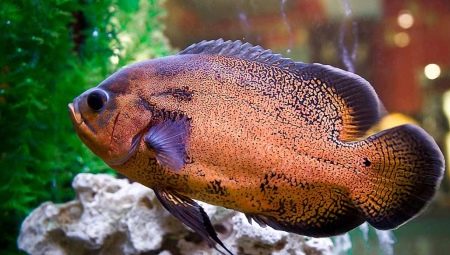The Ocular Astronotus (Oscar) is a rather large cichlid with a bright, saturated coloration native to South America. In addition to an interesting appearance, this creature is characterized as a smart and very entertaining fish.
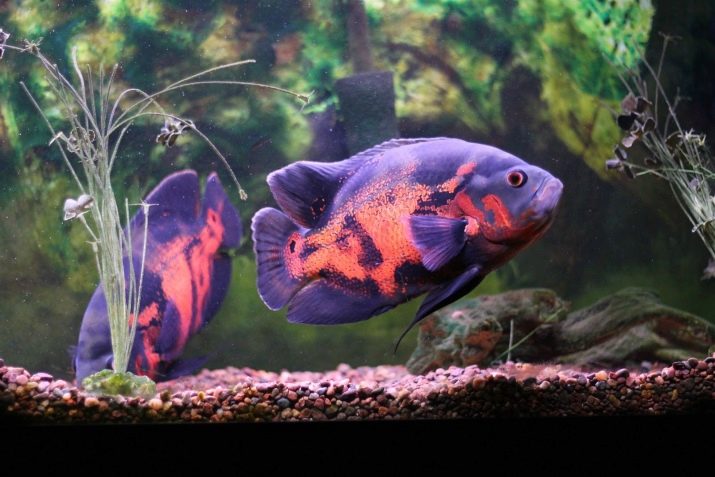
Description
The astronotus was discovered and described at the beginning of the 19th century. The fish was found in the Amazon basin, as well as in small streams of Parana, Rio Negro and Rio Paraguay. Later, they were artificially distributed in Australia, as well as in Florida and China, where the fish were able to adapt quite quickly and began to actively destroy the “indigenous” aquatic inhabitants.
In nature, these fish prefer ponds with a sandy or silty bottom., feed on crustaceans, worms and insect larvae. The astronotus has an oval, rather strong body with a pronounced head and large fleshy lips. Under natural conditions, an individual reaches 35 cm, but in an aquarium, the body length does not exceed 25 cm.
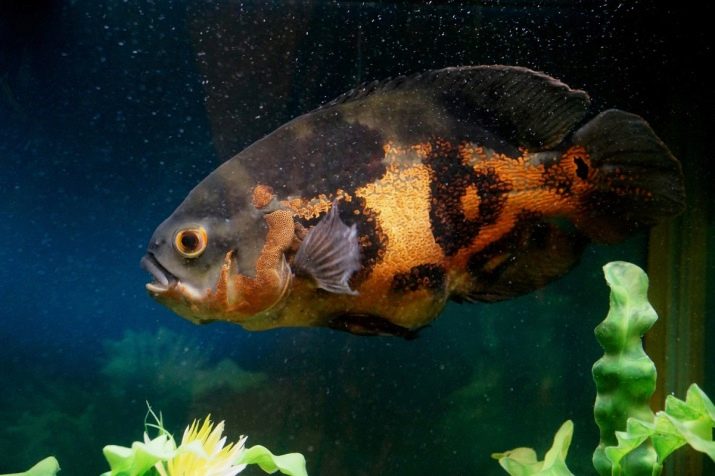
This graceful aquarium fish is one of those rare inhabitants of artificial ponds about which it is safe to say that they have an individual temperament and mind. Astronotus is notable for recognizing its owner: Oscar will closely monitor your movements while you do your household chores. And he does it much more consciously than all the other representatives of cichlids.
Some fish even allow stroking themselves in the manner of domestic cats and it is noticeable that they get some pleasure from this. If you wish, you can even feed your pet with it, but be prepared for the fact that he can even bite.
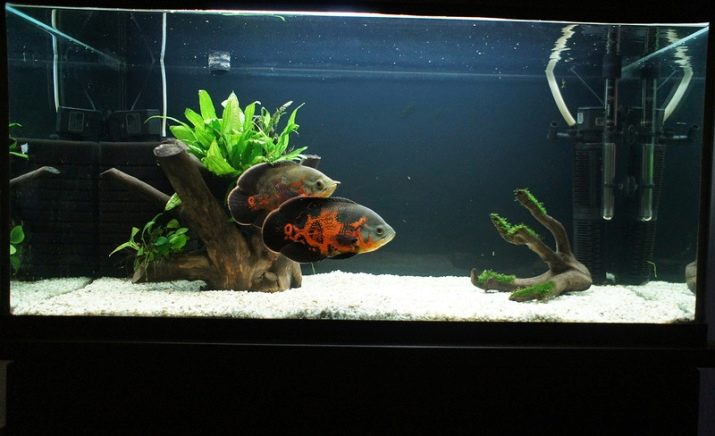
Although the wild species of astronotus is still very popular among aquarists, in recent years many new forms with amazing colors have been developed.
Oscars - undemanding to the care and conditions of keeping the fish. Even an inexperienced breeder can cope with their breeding, the only thing that can create complexity is the size of the pets. Astronotuses grow very quickly and, as they grow older, they eat all fish that are smaller in size, which is why it is desirable to keep them alone, and in fairly large containers - at least 300 liters.
In general, as in the case with other representatives of the aquarium fauna, the content of the Oscars has both its pros and cons. The benefits include:
- intelligence - Oscars are among the most socially sociable underwater inhabitants, therefore it is very interesting and fascinating to observe the behavior of these small fish;
- omnivorous - astronotuses are able to eat any food: frozen seafood, fresh bloodworms, crustaceans and worms, as well as dry flakes and granules, which are sold in any pet store;
- longevity - with good care, pets can live 10-15 years.
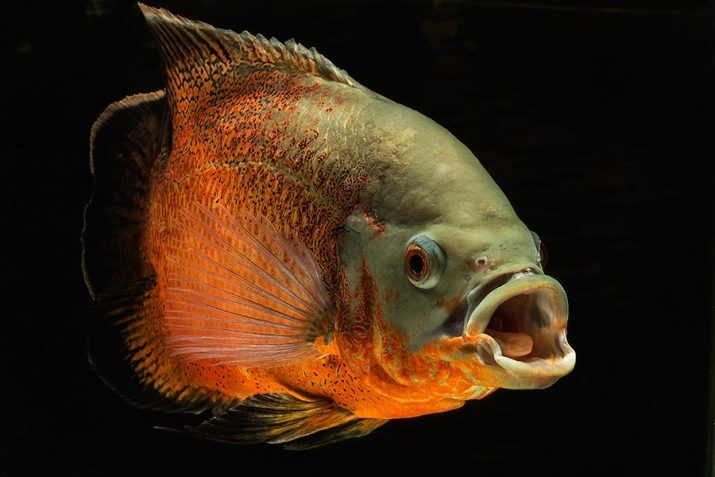
At the same time, breeders will certainly encounter some difficulties, in particular, they will need:
- the presence of a volumetric aquarium from 400 l or more;
- installation of a powerful filter and compresses for cleaning and aeration of water;
- frequent water changes.
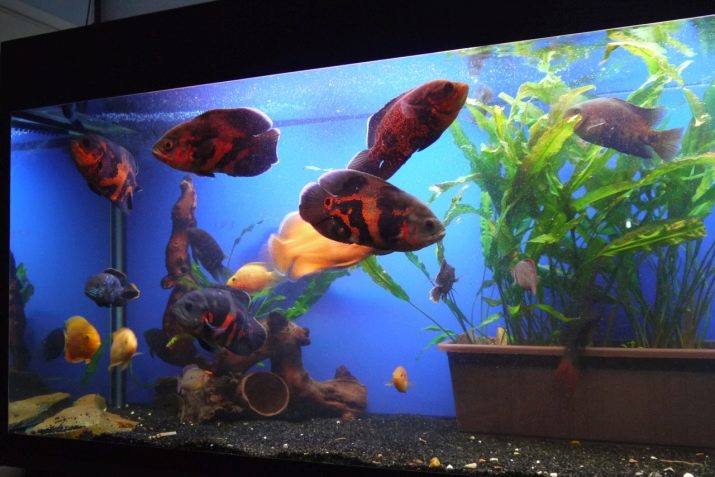
Astronotuses are characterized by mild sexual dimorphism, as well as inanimacy with the vast majority of other fish. In addition, you are unlikely to be able to plant live plants in a pond - astronotuses will certainly uproot and gnaw them.
How to distinguish a female from a male?
As we have already mentioned, the sexual characteristics of astronotuses are very poorly expressed, therefore only a specialist can determine the sex and distinguish between male and female, and only during spawning.
In most cases, breeders immediately acquire about a dozen fry (boys and girls) and grow them in one tank. Thus, in the process of communication, pets choose a partner. It is believed that females are slightly smaller than males, but this sign is very relative. The only pronounced difference is the formation of an ovipositorby means of which spawning occurs.

Species overview
Most astronotuses are derived artificially, and the main interspecific difference is their color. For example, albino astronotus has a white color, tiger fish have a speck on the tail, walnut representatives are brown in color, and red, as the name implies, has a scarlet color.
The following are considered the most popular aquarium oscars.
- Brindle - this representative of astronotuses can rightfully be called the ancestor of all fish. It is distinguished by a torso of a gray or brown hue with bright raspberry or orange spots, sometimes with a black edging. These fish have rather large fins, and near the tail there is a noticeably small, slightly vague spot that resembles the eye with its appearance.
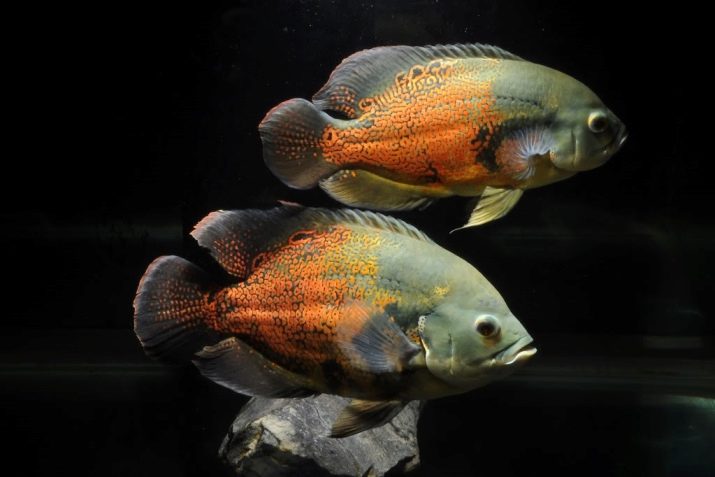
- Albino - already from the name of the fish it becomes clear that this astronotus has a white color with small interspersed red and large large red eyes. Dorsal and anal fins rather long and slightly rounded.
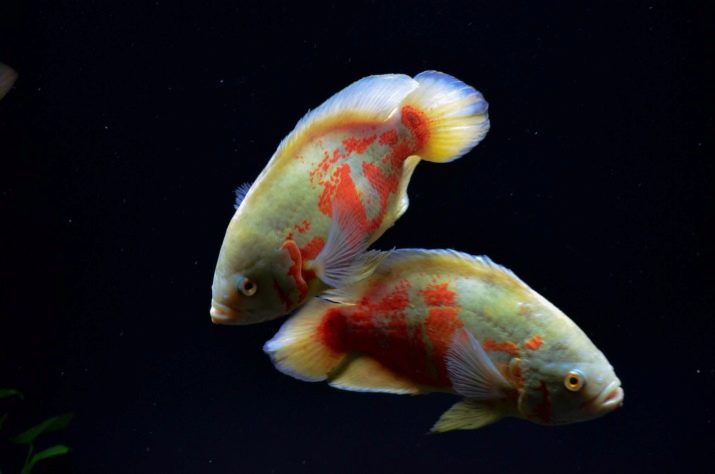
- Veil - the coloring of this representative of astronotuses can be different and uneven. The main distinguishing feature of these fish is their elongated fins, which, when moving pets in the water, create a rather spectacular impression.
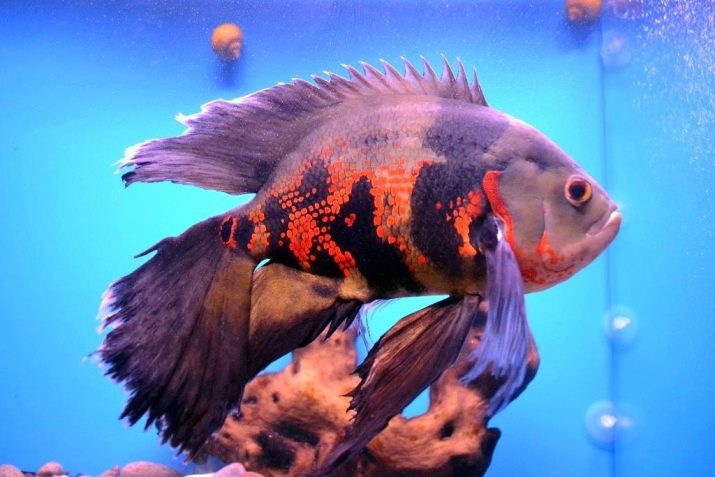
- Red - This fish boasts a uniform color and a complete absence of spots. As for the color, it can be either orange or scarlet. The fins are medium in size, with a black trim around the edges.

- Gold - This subspecies of fish was the result of a long selection.Visually differs from red only in color: the scales of these oscars are usually yellow or golden.

Content Features
Despite the fact that astronotuses are undemanding fish to care, nevertheless, when they are kept, a comfortable living environment should be created. The main requirement is pet size. So, for a pair of Oscars, an aquarium of at least 250 liters is required, and preferably from 400 liters.
Since the fish grows very quickly and reaches impressive size in the shortest time, it leaves a lot of vital products - as a result, the aquarium is overloaded with organics, which is fraught with poisoning of pets with nitrates and nitrites. To avoid problems, a powerful filtration system should be installed in the tank. It is important to regularly siphon the soil, as well as change the water by 30% once every 7-8 days.

Keep in mind that when this fish eats, pieces of food are scattered in all directions, so if your pets ’diet consists mainly of live food, you will need to change the fluid and clean the substrate more often.
As for the soil itself, the optimal solution would be to use river sand, gravel and pebbles 1-2 cm in size. You can lay out the bottom with large stones and snags - astronotus love to dig in and will probably overtake the entire substrate.
Plants should not be planted - the fish will very quickly tear them up or gnaw them. If you can’t do without an aquarium flora in any way, then give preference to its hard-leaved representatives.

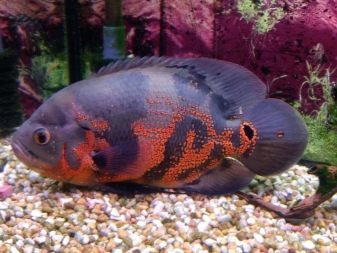
Aeration is very important for these fish. The fact is that astronotuses need a lot of oxygen, while they prefer water without flow - this means that it is better for breeders to supply gas from an external compressor installed on the surface of the reservoir. Keep in mind that all aquarium equipment and decoration elements must certainly be firmly fixed, since active fish like to play with them and attack.
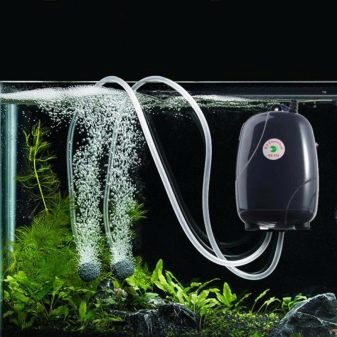
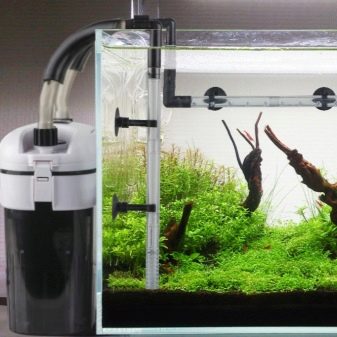
The astronotus is also very active in the feeding process, so it is advisable to use a lid, otherwise the spray will be everywhere.
Oscar-containing water must meet the following requirements:
- temperature - 22-28 degrees;
- acidity - 6.5-7.5 pH;
- rigidity - up to 25 units.
Unpretentious fish and feed, she can eat many products. However, make sure that the diet is varied. Dry feed should be taken as a basis., they must be supplemented with frozen seafood, as well as tadpoles, grasshoppers, grated beef heart and other large feeds.
You can offer your pets earthworms, but only if you first leave them in a small jar filled with water for 5-6 hours so that the earth completely leaves their intestines.
Be sure to include plant foods: spinach, oatmeal, mashed black bread or lettuce. Keep in mind that astronotuses are rather greedy and voracious fish that can eat much more than the recommended norm, but they won’t be good from it. It is very important not to overfeed the fish, it is advisable to offer them food once a day and arrange fasting days at least once every 7-10 days, that is, do not offer food at all.
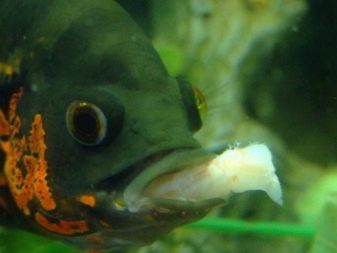
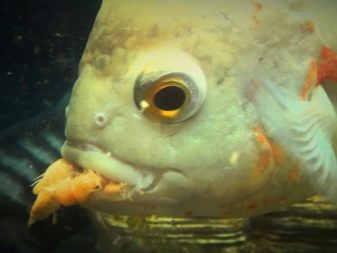
Failure to comply with the content requirements in fish often causes health problems. Pet diseases are divided into two types: infectious and non-infectious.
The most common pathology is hexamitosis. - It manifests itself in the appearance on the body and on the head of sores and mucus. Typically, the cause of the disease is a lack of vitamin C and a violation of the rules for feeding fish, for example, when pets are offered only beef or pork. Also, a problem may occur when using a carbon filter. Hexamitosis is usually treated with dietary adjustment and medication.
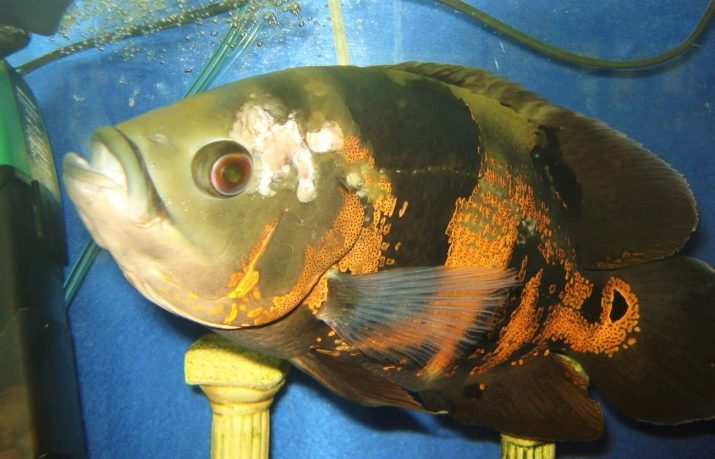
Quite often, breeders may notice that their astronotuses lie at the bottom and breathe heavily, and their stomach may swell: most likely, bowel obstruction. This happens again due to an unbalanced diet or too cold water in the aquarium. Oscar can help cope with a painful condition by adjusting the temperature of the water and adding sodium chloride to the tank at the rate of 1 tbsp. spoon for every 20 liters.
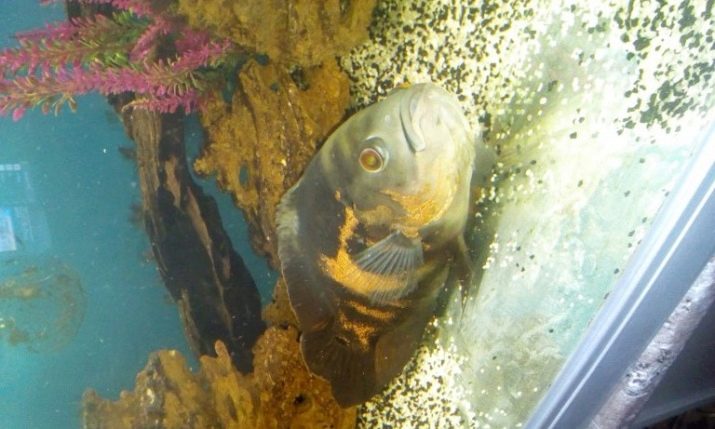
Often new individuals become the cause of disease in fish. In order to exclude infection, each fish after purchase must be quarantined for at least a week, and any new decor elements should also be soaked in potassium permanganate.
Do not give astronotuses a small river fish as food, it is often a source of the disease or a carrier of a dangerous ailment.
Compatible with other fish
Astronotus is primarily a predator, so it will necessarily swallow any aquarium fish that is smaller than its size. therefore maintenance with other aquatic inhabitants is only possible if they are also large.
Fish are especially aggressive during spawning, so it is advisable to set aside a separate aquarium for them. However, if your artificial pond has a volume of 1000 liters or more, you can keep Oscars along with non-conflict cichlids (for example, geophaguses), as well as large characin metinnis and ancistrus. However, having conceived such a neighborhood, one should certainly adhere to several rules:
- astronotus is allowed to run into the aquarium only after other fish have settled in it;
- it is advisable to put driftwood at the bottom so that catfish and other neighbors can hide in them in case of a dangerous situation.
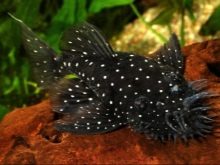
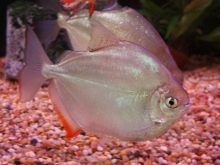
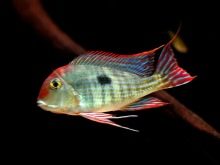
Breeding
Astronotuses reach puberty at the age of about 2 years, by this time they grow to 10-15 cm, after which they are considered ready for spawning. Before breeding begins, it is necessary to move them to a 100-liter spawning ground and raise the water temperature by a couple of degrees, as well as increase the amount of feed. Lighting is done around the clock, but weak.
During spawning, the color of males and females becomes brighter and more saturated. When future parents feel ready, they will begin to look for a place to spawn and clear it. Usually fish choose flat stones, so you should take care of their presence in the aquarium in advance. The female lays 1.5-2 thousand eggs, after which the male develops the vas deferens and he carries out fertilization. All the manipulations last about 4-5 hours.
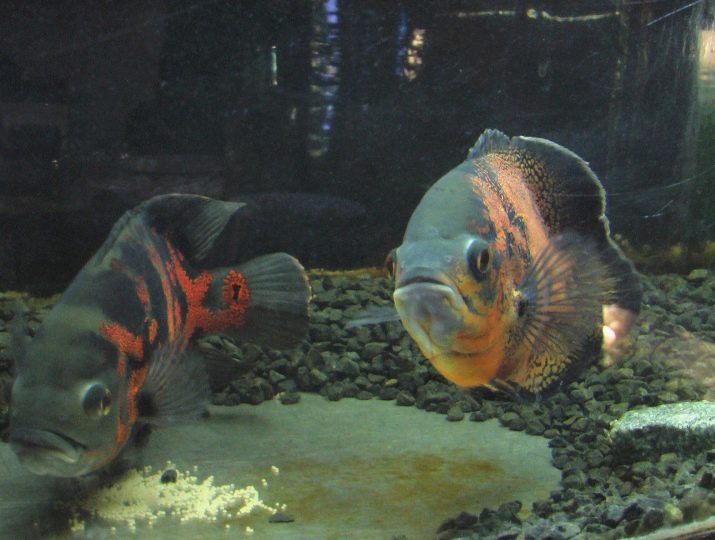
Eggs are initially beige and opaque, but in rare cases can change their shade.
Parents take care of the fry until they begin to swim on their own. Incubation lasts about 50 hours, starting from 4 days the young growth does not lie still, but moves in the water column, at this moment the male and the female are better to be put back into the common reservoir, otherwise the risk of eating their children is not excluded. Fry is fed twice a day, it is advisable to use artemia or cyclops.
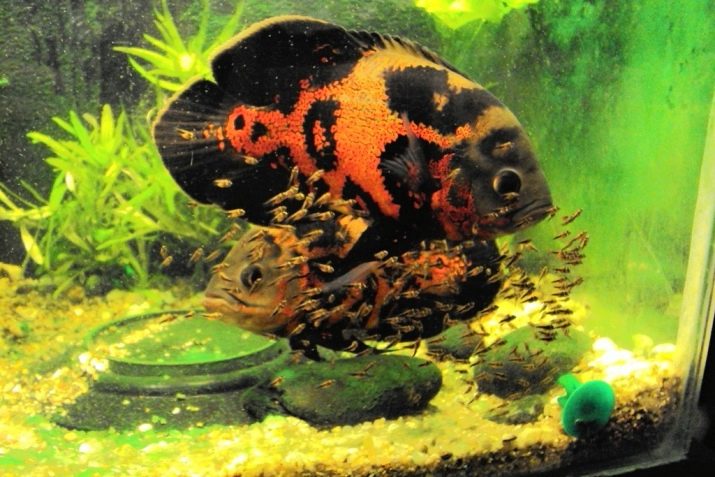
Astronotuses have a high birth rate when breeding at home. Quite often they are bred on an industrial scale on special farms and fish farms. However, keeping such fish in the aquarium is a pretty serious step, so you need to think carefully before you breed Oscars at home. The fact is that many are trying to breed and sell astronotuses, only the number of buyers is much smaller, the demand for these fish is small, and they grow very, very quickly.

Finally I want to note that astronotuses are considered the smartest fish. They always respond to a human voice and can succumb to training.Many people like the decorative look of these fish and the ability to choose pets of the most exotic colors, but breeders need to take care of the large aquarium and pay attention to its contents.
But if you are not afraid of difficulties, then astronotuses will delight you every day with their impressive dimensions, beauty and entertaining behavior. Everyone in any situation will find something of their own in astronotuses, and this is the main reason why these fish are so popular today.
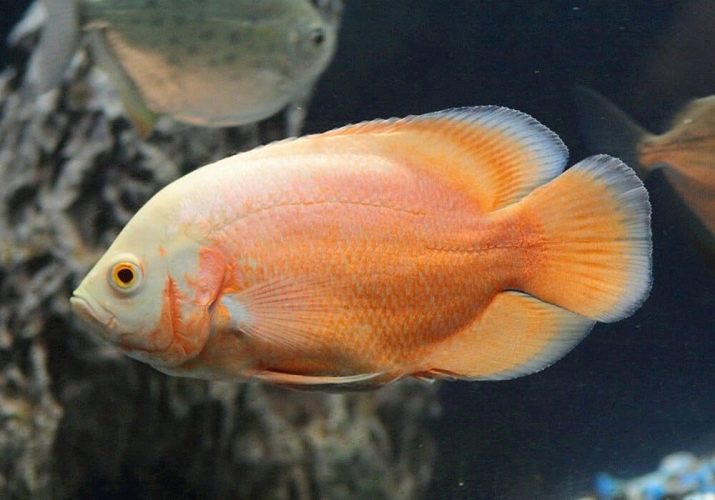
See the video below for more on astronotuses.
